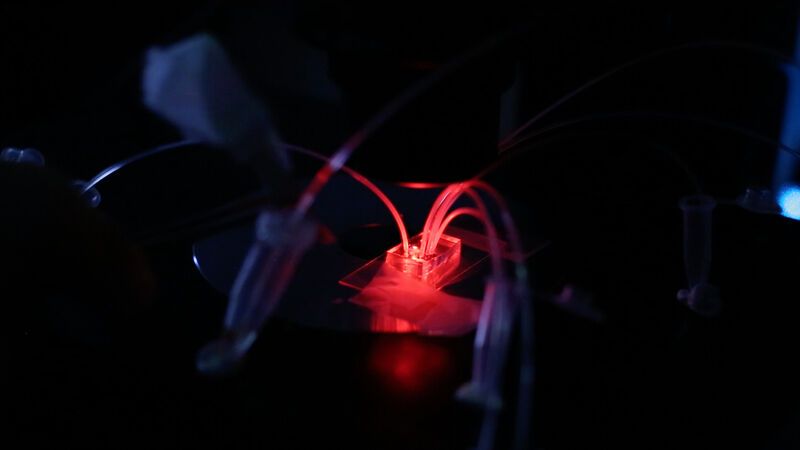Research

Chemical Biology: From Mechanism to Droplet Technologies
Nature has evolved the most amazing functional biomolecules and we want to know how they work: first by gaining a fundamental understanding of the principles responsible for molecular recognition processes in biology. But then also by manipulating and ultimately making functional molecules - to pass the test set by Richard Feynman ("What I cannot create, I do not understand."). Our long-term objective is to extend the mechanistic lessons learned to potential applications in biotechnology, synthetic biology and medicine.
We tackle the challenge of biomimicry using an eclectic mix of techniques - borrowed from whichever area of experimental science that promises to shed light on how functional biomolecules are brought about. We are developing technologies for biochemical analysis in which droplets generated in microfluidic devices substitute for the classical test tube: these are used as high-throughput screening tools or for single cell analysis. In addition our work involves e.g. kinetic analysis of organic and enzymatic reaction mechanisms, protein engineering, biophysics, structrural analysis by X-ray crystallography, and molecular biology techniques for directed evolution.
• Understanding Functional Biomolecules
Enzymes are the all-purpose catalysts that make the Chemistry of Life run smoothly and efficiently, under the mildest, ‘greenest’ conditions. We investigate how an enzyme finds its mechanism by delineating the process catalysed by natural enzymes in detail, and compare it to the uncatalysed solution reaction or the reaction catalysed self-made synthetic enzyme models (e.g. derivatised polymers) that tell us how primordial enzymes may have worked.
Enzymes must recognise ground and transition states, so we also study how protein binders can be made to selectively target molecules of interest. For example, we investigate antibody-like binders and try to combine them with catalytic machinery, to provide new opportunities for therapeutic intervention.
The molecular recognition and cell biology of drug delivery reagents is a further test case, where we e.g. use peptide dendrimers and/or polyethylene imines to promote passage of nucleic acid cargo into the cell or even the nucleus. Efficient transfection is the prerequisite for non-viral gene therapy.
• Understanding the Molecular Basis of Darwinian Evolution
Nature has generated functional molecules by creating large pools of variants and then selecting 'winners' through many rounds of evolution that have taken place over millions of years. To reproduce Darwinian evolution in the test tube we must understand what increases the chance of success in library approaches. Will there be mechanistic rules for such combinatorial experiments that allow us to define a strategy for laboratory evolution and can we gain mechanistic insight into the underlying recognition processes by systematic analysis of 'fitness landscapes' (i.e. complex descriptor spaces relating e.g. sequence and activity). Can understanding of at this 'systems' level be as powerful as in-depth analysis of functional biomolecules has proven to be?
• Technologies for Synthetic Biology
The emerging field of synthetic biology has set the goal of constructing biological devices for useful purposes. These devices may be engineered from existing 'parts', but in many cases new ones have to be generated. Darwinian evolution provides a route to new functional molecules, but new high-throughput technologies for the synthesis, assay and analysis of large molecular ensembles are needed. The traditional approach of studying individual molecules cannot cope with the library sizes required to successfully identify new functional molecules. We have developed lab-on-a-chip systems for the screening of millions of library members in picolitre water-in-oil droplets in a few hours. We thus select new enzyme catalysts for applications in bioenergy production, the pharmaceutical industry and for medical purposes. The development of analytical interfaces (e.g. to measure reaction rates in droplets) is the basis for the systematic analysis of the enormous amounts of data generated.
• Droplet based approaches for developmental biology
See our recent publications...
Open-source Databases:
Microfluidic Designs: The Hollfelder group has established an open-source database, DropBase, for recording and distributing microdroplet device designs. Dropbase can be found here.
Code: Computer scripts written by lab members for data analysis can be found here.
We thank our funders, and acknowledge our many fruitful international collaborations, e.g. via recent EU Marie Curie Research Training NetworksPhosChemRec, ENEFP and ProSA, MMBio and ES-Cat.
